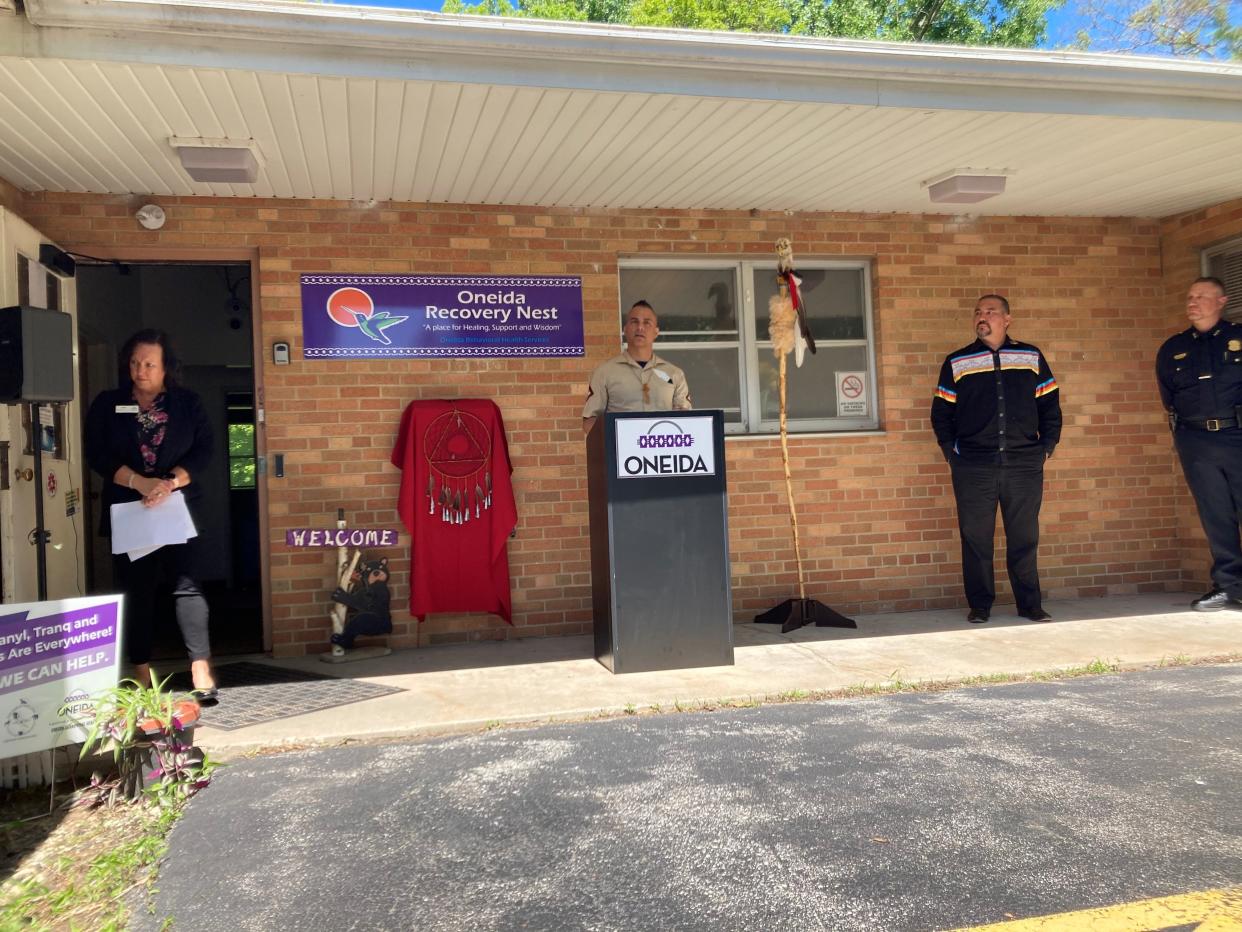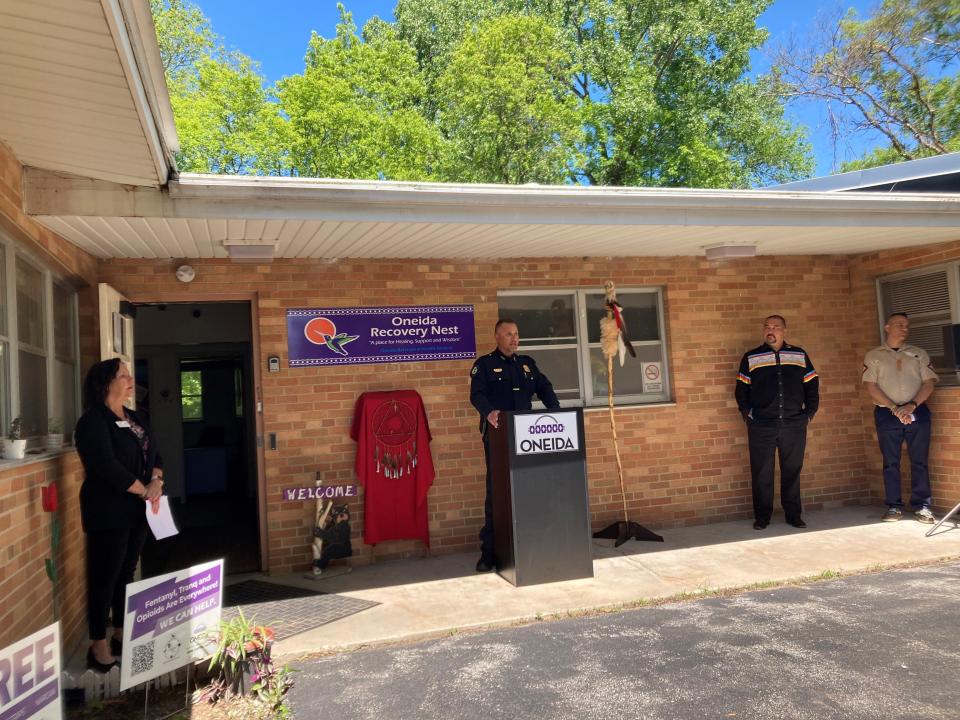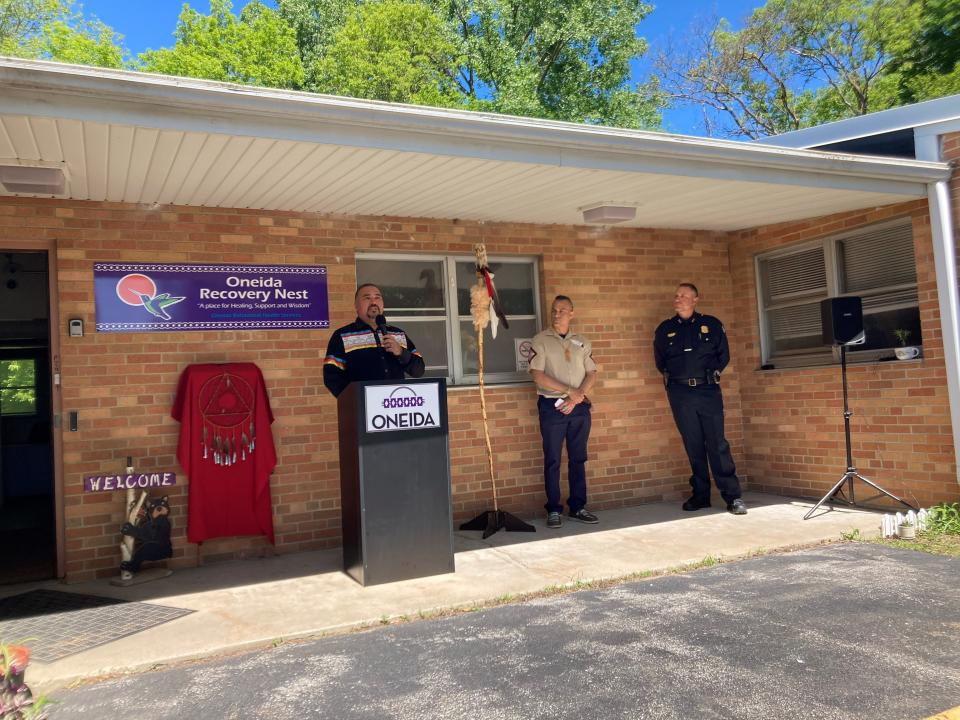Fentanyl overdoses especially hurt tribal nations. The Fentanyl Is Everywhere campaign aims to help

ONEIDA NATION – Rain pounded on Patrick Danforth's tent outside of Jacksonville, Florida, his only protection from the elements, the alligators and a life ravaged by drugs and alcohol.
It was 2020. Danforth had been struggling with addiction since his first sip of alcohol, although he wouldn't be able to admit it until around 2008. But after 12 years of relapsing and moving farther from the "red road," the spiritual road to recovery often referenced in Indigenous circles, it was in this tent, homeless in the state he grew up in, hiding from alligators, that he finally understood rock bottom.
"This is where one drink took me to. For a normal person, that wouldn't happen. That was a real eye-opener: I'm homeless, I'm unemployable, I'm experiencing a mental health crisis, and I have active addiction and alcoholism," Danforth, 46, said. "And this is where that wandering took me to."
Danforth, who is Oneida, relocated to his roots after college. He never had an opportunity to grow up around traditional teachings, to learn about his tribal heritage. He barely knew what a reservation was before his arrival to the Oneida Nation.
Fast forward to today and Danforth is four years sober and a recovery coach for the Oneida Nation. But Danforth's experience with cultural disconnection is a major part of what leads many in the Indigenous community to a life of substance abuse, addiction and overdosing, said Tehassi Hill, chairperson of the Oneida Nation.
Fentanyl, since 2016, has decimated tribal life at an alarming rate, in a similar fashion that it has across the state and nation. But fentanyl on reservations is particular, capable of ripping apart tight-knit communities whose members already struggle with centuries of generational trauma. It's part of why, on a sunny Thursday late morning, Hill, Danforth, Oneida Behavioral Health Director Mari Kriescher, and Joel Maxam, assistant chief of the Oneida Police, gathered outside of Oneida Recovery Nest, 1240 Packerland Drive, to introduce the "Fentanyl Is Everywhere Campaign."
The timing of the event is crucial, said Kriescher.
"We wanted to start the Fentanyl Is Everywhere Campaign by Memorial Day because it's the start of summer. And summer is a time when the weather is nicer, we have more outdoor activities and more parties are happening," Kriescher said. "That's also, potentially, where more people will overdose. We were hoping to get it out during the summertime when we know that more use is happening."
Fentanyl is showing up in just about every drug
The Fentanyl Is Everywhere Campaign aims to raise awareness about fentanyl's ubiquity in the illicit drug market. The campaign will use social media, yard signs, window clings, business card handouts and outreach to local media. Part of awareness raising includes distribution of harm-reduction tools like fentanyl strips, Narcan and, eventually, xylazine, or "tranq" strips.
Awareness will also come through educational efforts.
Maxam, from the Oneida Police, emphasized the fact that he and fellow law enforcement officers are discovering fentanyl, quite literally, in every drug, from opioids to cannabis. That's especially dangerous because of fentanyl's deadly potency — even the smallest amount, the equivalent of 10 to 15 grains of salt, is considered a lethal dose, according to the U.S. Drug Enforcement Administration.

In his 23 years with law enforcement, Maxam has watched this deadly drug evolve. Fentanyl showed up in the Oneida Nation in 2015 in the form of a patch. People would dip the patch in fentanyl-laced water, presumably with the intention of getting high from fentanyl. But it's since permeated practically every drug with or without the user's knowledge.
"What we're seeing now is that it's in prescription pill form, it's in marijuana, it's in edibles, it's in everything, which makes it that much more dangerous," Maxam said. "Due to its lethality, we're seeing overdoses, both fatal and non-fatal, increasing. And those are only the ones we know about."
Fentanyl's deadly siege in Wisconsin might have arrived a little more than a decade ago, but the problem is only worsening. Last year, Forward Analytics, a Wisconsin-based research organization, released a report showing that fentanyl is not only killing people, it's doing so at an exponential rate, making it the No. 1 killer of adults between 25 and 54 in the state.
And tribal nations in Wisconsin are losing people at nearly three times the rate of the state to opioid overdose deaths, according to the Wisconsin Department of Health Services. In 2021 alone, 1,358 American Indian and Alaska Native individuals died from an opioid overdose, the highest rate of any racial or ethnic group, according to the Centers for Disease Control and Prevention.
Since the early years of contact between European settlers and Indigenous peoples, the introduction of alcohol and illicit drugs has been a means of coping with the severing of tribal roots, said Hill, chair of the Oneida Nation.

"Every decade, there seems to be a new drug that enters our community. Because of the loss of our language, loss of our lands, loss of our family structures, going from a communal society to a nuclear family, the effects boarding schools had, how we parent our kids, our children and grandchildren, all that kind of compounds over time," Hill said. "That's how we get to today, where people are looking for any possible escape from their internal traumas."
The power of recovery
Danforth joked that he and rap artist Eminem share a sobriety date of April 20, although Eminem's got him beat by a decade. He knows the road to recovery looks different for everybody, and he knows that not everyone in recovery is necessarily able to maintain sobriety.
He falls back to the common adage often used in recovery circles, "If nothing changes, nothing changes." Taking that first step is crucial. Finding rock bottom in a tent in Florida, at least for Danforth, presented him with some hard choices. He could change, or he could stay in the tent, away from the community, being battered by an unpredictable storm.
Once Danforth went through recovery, he understood his higher calling. He would help people in the community recover.

"What I didn't realize is the downward spiral actually made me a better recovery coach. Going through literal hell and back again is really what gave me that lived experience. And with that, I made the determination for my next opportunity to get certified as a professional recovery coach," Danforth said.
Midway through his conversation with the newspaper, Danforth joined Oneida leadership for a photo, brandishing the eagle staff, a wooden pole topped with an eagle head. Danforth, Hill, Kriescher and Maxam held various parts of the staff, their hands stacked one over the other.
The eagle is an important symbol for the Oneida Nation. As the strongest and highest flying bird, the eagle is said to watch over the Haudenosaunee people and warn them of dangers from above. Danforth especially appreciates the eagle staff, because it shows a path forward, a way to feel patriotic without the loss of heritage. It's a way to honor his identity and the country he also calls home in a way that feels decolonized from its ugly past, he said.
"The Eagle Staff precedes the American flag. The reason for it is to pay respect to the First Nations and to pay respect to the eagle, an important symbol of our nation," Danforth said. "It's very sacred."
The Fentanyl Is Everywhere Campaign encourages anyone struggling with addiction to call or text 211 for local services and resources and 988 for suicide prevention. People are also encouraged to contact the local county crisis hotline 920-436-8888 for Brown County or 920-832-4646 for Outagamie County.
Natalie Eilbert covers mental health issues for the Milwaukee Journal Sentinel. She welcomes story tips and feedback. You can reach her at neilbert@gannett.com or view her Twitter profile at @natalie_eilbert. If you or someone you know is dealing with suicidal thoughts, call the National Suicide Prevention Lifeline at 988 or text "Hopeline" to the National Crisis Text Line at 741-741.
This article originally appeared on Milwaukee Journal Sentinel: Oneida Nation launches its 'Fentanyl Is Everywhere' campaign

